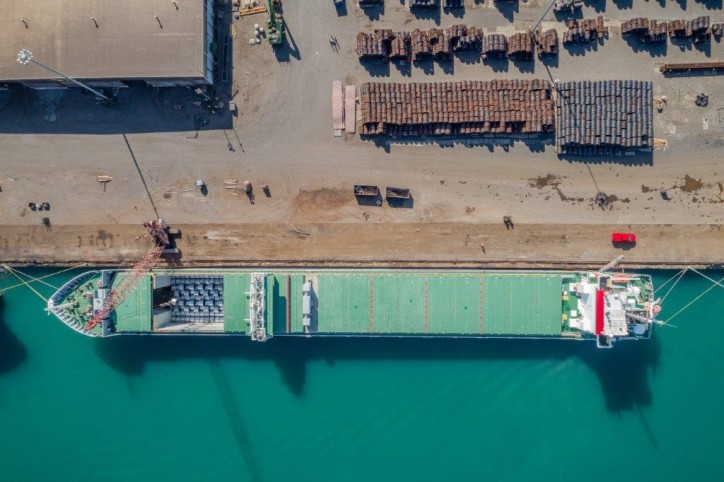The Great Lakes Seaway Partnership reports an increase in St. Lawrence Seaway traffic with year-to-date (YTD) total cargo shipments through October of 30.5 million metric tons, a four percent increase over the same timeframe last year. Total vessel transits were also up by five percent over the same time in 2017.
As domestic and international shippers prepare for peak season, Great Lakes Seaway shipping continues growth while sustaining optimal capacity for shippers at American Great Lakes ports.

Top Performing Cargoes
Ports across the Great Lakes, including but not limited to Green Bay (Wisc.), Milwaukee (Wisc.), Detroit (Mich.), Toledo (Ohio) and Ashtabula (Ohio), supported the traffic growth in October with top performing cargoes keeping Seaway traffic well above the five-year average:
| Cargo | Metric Tons | Percent Increase* |
| Liquid Bulk | 3.7 million | 18.8% |
| Coal | 2.0 million | 17.1% |
| U.S. Grain | 1.9 million | 44.2% |
| Cement & Clinkers | 1.6 million | 20.7% |
| Steel Slabs | 546,000 | 33.4% |
| Stone | 430,000 | 20.6% |
| Ores & Concentrates | 207,000 | |
| Pig Iron | 157,000 |
*All percentage increases compared to the same time last year
“We are proud to see the positive trend continue through the beginning of Q4. We project a sustained trendline, resulting in a strong year for Great Lakes Seaway shipping, particularly with respect to iron ore, grain and liquid bulk shipments,” says Craig H. Middlebrook, Deputy Administrator of the U.S. Saint Lawrence Seaway Development Corporation. “Shippers are demanding both bulk and breakbulk cargoes, which can be moved safely, efficiently and more environmentally friendly on marine transportation than other modes – Great Lakes shipping emits 19 percent less carbon dioxide than rail and 533 percent less than trucks. The advantages of maritime transportation help support continued growth in manufacturing, construction and other industries throughout the region.”
The U.S. ports of Chicago (Illinois) and Milwaukee (Wisconsin) reported notable activity in October.
“Seaway cargo at Port Milwaukee continues to move at a strong pace with steel imports and grain exports leading the way. Seaway tonnage is likely to exceed last year’s mark,” says Adam Schlicht, Port Director, Port Milwaukee. “The biggest change over 2017 is a substantial increase in liquid bulk cargo. Milwaukee refurbished its liquid bulk pier and shipments are up 71% so far this year.”
“Having received the Saint Lawrence Development Corporation’s Pacesetter Award this year, the Illinois International Port District (IIPD) has continued an upward trajectory, which is demonstrated and highlighted through an outstanding October. Despite steel being down due to the 232 tariffs, the IIPD experienced an influx of new minerals, metals and bulk through domestic cargo,” says Clayton Harris III, Executive Director, Illinois International Port District. “In October alone, the IIPD saw an average of 40 – 45 barges a day and still maintained one of the larger exporting operations with over 1,800 containers, year to date.”
Essential Commodities to Keep Americans Moving and Safe this Winter
Demand continues across the American heartland for commodities that are vital to the economy. This is visible in the trade and transportation of commodities essential for the steel (e.g. iron ore, pig iron, etc.) and agriculture (e.g. grain) industries as well as commodities that keep our nation moving during the winter (e.g. salt).
The battle against winter starts with Great Lakes Seaway shipping – transporting salt from the upper Great Lakes (e.g. Port of Milwaukee) to the lower lakes (e.g. Port of Chicago or Port of Toledo) via American ships or “Lakers” to ensure that salt arrives just in time to prevent falling snow or rain from freezing, creating dangerous driving conditions for motorists. Lakers are traversing the Great Lakes continually to help create stock piles of salt in regions prone to lake-effect snow or heavy winter storms to ensure that inventory is not depleted.

As winter months arrive and the end of the navigation season approaches at the end of December, Great Lakes Seaway shipping maintains a positive trend – 4% greater traffic and more international ships or “Salties” than in 2017 during the same period.
About the Great Lakes Seaway Partnership
The Great Lakes Seaway Partnership is a coalition of leading US and Canadian maritime organizations working to enhance public understanding of the benefits of commercial shipping in the Great Lakes Seaway region of North America. The organization manages an education-focused communications program, sponsors research and works closely with media, policy makers, community groups, allied industries, environmental stakeholders and the general public to highlight the positive attributes of marine transportation.
The Great Lakes-St. Lawrence Seaway System is a marine highway that extends 2,300 miles from the Atlantic Ocean to the Great Lakes. Approximately 160 million tons of cargo travels over the System on an annual basis, supporting more than 237,000 jobs and $35 billion in economic activity.
Source: Great Lakes Seaway
For cruise shipping on St Lawrence Seaway see at CruiseMapper